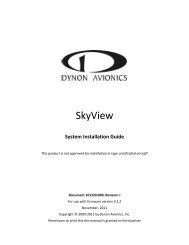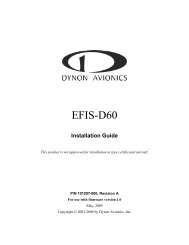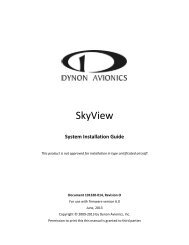EFIS-D100 Installation Guide - Dynon Avionics
EFIS-D100 Installation Guide - Dynon Avionics
EFIS-D100 Installation Guide - Dynon Avionics
You also want an ePaper? Increase the reach of your titles
YUMPU automatically turns print PDFs into web optimized ePapers that Google loves.
Autopilot <strong>Installation</strong> and Configuration<br />
MAX AIRSPEED – REDUCE POWER<br />
Airspeed Maximum is specified in knots, kilometers/hr, or miles/hr, depending on the units<br />
chosen in the <strong>EFIS</strong> > SETUP > UNITS > IAS menu. Maximum/default: 5% below V NE .<br />
To set the AIRSP MAX, perform the following (continuing from AIRSP MIN):<br />
DOWN▼ > (AIRSP MAX: value is highlighted)<br />
Press DEC - and INC + to adjust APRSP MAX to preferred initial setting for the aircraft.<br />
Step 4e – Set Pitch Servo VSPD Maximum: The PITCH SERVO > VSPD MAX parameter is<br />
specified in feet/minute (or meters/second, if the setting chosen in the <strong>EFIS</strong> > SETUP > UNITS<br />
> ALT is METERS). This parameter sets the average vertical speed the autopilot will command<br />
for climbs and descents. If you set this value above a vertical speed the aircraft can achieve, the<br />
AP will run into the airspeed limiter in climbs and descents. Minimum: 100 feet/minute; default:<br />
500 feet/minute; maximum: 4,000 feet/minute.<br />
On the <strong>EFIS</strong>, perform the following (continuing from Pitch Servo Airspeed Maximum):<br />
DOWN▼ > (VSPD MAX: value is highlighted)<br />
Press DEC - and INC + to adjust VSPD MAX to preferred initial setting for the aircraft.<br />
> BACK > EXIT<br />
STEP 5 – DISENGAGE/CWS BUTTON CONFIGURATION<br />
We recommend that you perform the following on the ground at zero airspeed.<br />
Step 5a – Enable/Disable Hold to Engage: Setting HOLD TO ENGAGE to Y allows you to<br />
engage the Autopilot by holding the Disengage/CWS Button for more than 2 seconds. This<br />
allows for a convenient alternative to engaging the Autopilot via the menus and/or AP74 AP<br />
button. Default is N.<br />
When this mode is active, anytime the autopilot is disengaged you can engage it by pressing and<br />
holding the Disengage/CWS Button for more than 2 seconds. Note that after 2 seconds, the AP<br />
status indicator at lower left of the <strong>EFIS</strong> screen shows AP:CWS-CWS. This indicates that the<br />
servos are in Control Wheel Steering mode and are waiting for the button to be released before<br />
engaging.<br />
Step 5b – Enable/Disable Broken Disengage Line Detect: The BUTTON CONFIG ><br />
RESISTOR INST parameter should only be set to Y if the optional 5 kΩ resistor is installed<br />
across the Disengage/CWS Button, as shown on page 6-3. If the resistor is installed and this<br />
parameter is set to Y, the <strong>EFIS</strong> continuously monitors the AP Disengage/CWS Button circuit for<br />
proper resistance. If a broken line is detected the following message is displayed on the <strong>EFIS</strong>:<br />
AUTOPILOT DISCONNECT LINE BROKEN<br />
If the AP is engaged when this condition is detected, it will remain engaged.<br />
Set to Y if the optional 5 kΩ resistor is installed across the 2 terminals of the Disengage/CWS<br />
Button. Set to N if the resistor is not installed. Default is N.<br />
Step 5c – Enable/Disable Control Wheel Steering: When set to Y, the BUTTON CONFIG ><br />
CTRL WHEEL STEER > ENABLED option enables a secondary mode of the AP<br />
Disengage/CWS Button. This mode allows you to be flying under AP control, press and hold the<br />
<strong>EFIS</strong>-<strong>D100</strong> <strong>Installation</strong> <strong>Guide</strong> 6-21
















